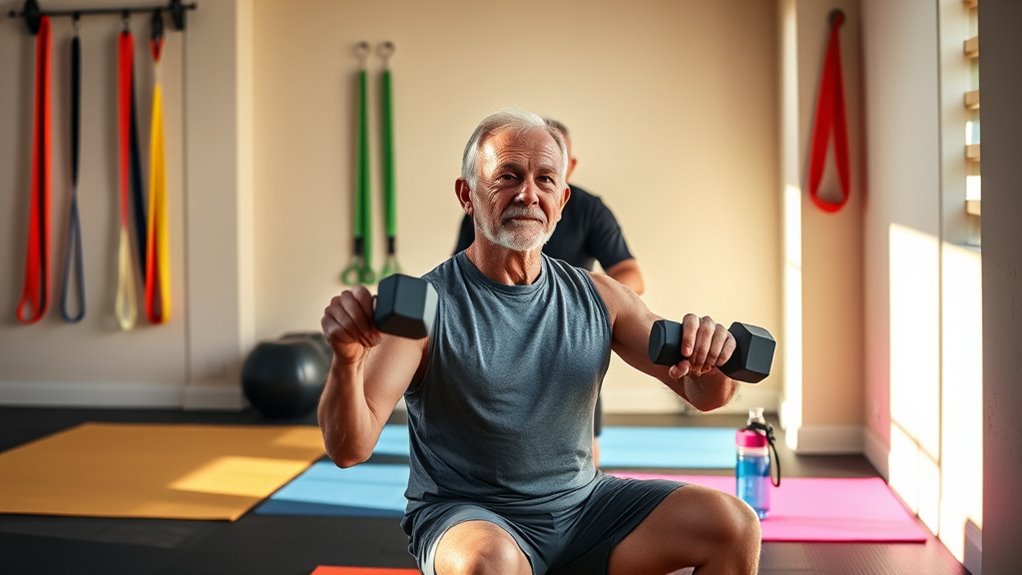Strength training is essential for you as a senior, helping combat muscle loss and enhancing mobility for daily activities. Start with light weights and focus on mastering your form before progressing. Incorporate exercises like squats, lunges, and push-ups into your routine. Remember to warm up for 5 to 10 minutes and allow time for recovery. By prioritizing safety and proper technique, you can stay powerful and independent as you age. Explore effective routines to get started!
Key Takeaways
- Begin with light weights and focus on mastering proper form through bodyweight exercises before gradually increasing resistance.
- Incorporate exercises like squats, lunges, push-ups, and deadlifts to enhance strength and functional fitness.
- Warm up for 5 to 10 minutes with light activities to prepare the body and minimize injury risk.
- Modify exercises to suit individual abilities, ensuring safety and effectiveness, while listening to the body for discomfort.
- Allow 24 to 48 hours of recovery between strength training sessions, and use gentle stretches to promote flexibility and relaxation.
The Importance of Strength Training for Seniors

As you age, maintaining your strength becomes essential, not just for everyday tasks but also for your overall health.
Strength training is vital for seniors, as it combats sarcopenia, the age-related loss of muscle mass, enhancing your mobility and functional fitness. Regular resistance training can improve bone density, greatly reducing your risk of osteoporosis and fractures. Additionally, end-of-life care options emphasize the importance of physical strength in maintaining independence and quality of life. Engaging in strong communication skills can also foster better relationships, which is vital for emotional support as you navigate aging. Furthermore, incorporating support systems such as community resources can enhance your journey toward maintaining strength. Incorporating antioxidant-rich foods into your diet can further support your overall health and recovery from workouts.
Strength training is crucial for seniors, fighting muscle loss and improving mobility, while enhancing bone density and reducing fracture risk.
You’ll find that daily activities, like lifting groceries or climbing stairs, become easier and safer. Additionally, strength training boosts your metabolism, aiding in weight management and overall well-being.
It’s not just about physical benefits; studies show that it also supports mental health by reducing symptoms of depression and anxiety while enhancing cognitive function. Prioritizing strength training can truly transform your life as you age, especially when combined with proper retirement planning to ensure you have the resources to maintain an active lifestyle.
Safety Precautions for Weight Training

Before starting any weight training program, it’s essential to consult your healthcare provider to guarantee it suits your individual health needs. Focus on mastering proper form with bodyweight exercises first, as this helps prevent injuries. Additionally, remember that strong communication skills can enhance your understanding of techniques and feedback during training sessions. Furthermore, maintaining a consistent routine in your exercise regimen can contribute to overall physical stability and well-being. Engaging in regular physical activity is crucial for emotional and psychological growth as it promotes overall health and well-being. It’s also beneficial to consider financial planning to manage any costs associated with fitness programs or equipment effectively. Incorporating freshly squeezed juices into your diet can provide essential nutrients to support your training efforts.
Consult Healthcare Provider
Consulting your healthcare provider is essential for ensuring your safety when starting a weight training program. They’ll assess your health status and discuss any pre-existing conditions or medications that might affect your routine. Additionally, understanding financial considerations related to health and fitness can help you plan your weight training expenses effectively.
By providing tailored advice, your healthcare professional can recommend specific modifications or exercises that suit your physical capabilities and minimize injury risk. Regular check-ins will help monitor progress and adjust your exercise program as needed, keeping it aligned with your changing health conditions. Furthermore, understanding emotional dysregulation associated with stress can improve your focus and consistency in training. Engaging in a guided assessment can boost your confidence and reassure you as you commence your weight training journey. Additionally, utilizing audiometric testing can help identify any hearing issues that may affect your ability to follow instructions effectively. Remember, prioritizing safety and personalized guidance is key to enjoying the benefits of strength training. Additionally, understanding the importance of open communication can help address any underlying stress that may impact your training efforts.
Focus on Proper Form
Proper form is essential when it comes to weight training, especially for seniors. Maintaining proper body alignment reduces the risk of injury. Here are some key points to keep in mind:
- Engage Core Muscles: Always activate your core to support your spine during exercises. Incorporating essential oils for muscle recovery can also enhance overall performance and reduce soreness.
- Maintain a Neutral Spine: Keep your back straight to prevent strain, especially in movements like deadlifts and squats. BPD often involves identity disturbance, which can affect focus and motivation during workouts. Additionally, proper lighting design in your workout space can enhance visibility and safety.
- Start with Light Weights: Begin with lighter weights to master the technique before increasing resistance. This approach allows you to focus on your form, which is crucial in avoiding injuries and ensuring long-term progress.
- Consult a Fitness Professional: Regularly check in with a trainer to guarantee correct form and necessary modifications.
In addition, incorporating emotional regulation techniques can enhance focus and reduce anxiety during workouts.
Modify for Individual Abilities
When starting a weight training program, it’s important to modify exercises based on your individual abilities to guarantee safety and effectiveness.
Remember, strength training helps improve overall health, but using lighter weights or bodyweight movements can focus on form and avoid injury, especially if you’re a beginner or have existing health issues. Ensuring proper sleep safety guidelines is essential not only for recovery but also for preventing fatigue-related injuries.
Prioritize safety by making sure your workout area is clear and that you’re wearing proper footwear to prevent slips and falls.
If balance is a concern, consider modifications like seated or incline push-ups.
Always listen to your body; if you experience discomfort or pain, stop the exercise and consult a professional for alternatives.
Adapting your routine to your needs guarantees a safer and more effective training experience. Engaging in regular physical activity can also help reduce anxiety and depression symptoms in seniors, enhancing overall well-being.
Overview of Weight Training Routines

As you explore weight training routines tailored for seniors, it’s essential to focus on exercises that target major muscle groups while enhancing strength and mobility.
These routines help older adults build strength and improve overall fitness. Here’s a simple overview of what to include:
Effective routines empower seniors to strengthen their bodies and enhance overall fitness levels.
- Bodyweight exercises: Start with squats and push-ups to build a solid strength foundation.
- Light weights: Incorporate dumbbells for exercises like lunges, gradually increasing resistance.
- Balance and coordination: Add activities like standing on one leg to enhance stability.
- Flexibility training: Integrate stretching to reduce the risk of injury and improve mobility.
Aim for strength training at least twice a week, focusing on 2-3 sets of 10-15 repetitions per exercise.
Effective Warm-Up Exercises

Warming up is essential for preparing your body and reducing the risk of injury during workouts.
You can start with simple activities like jogging in place or doing high knees to get your heart rate up.
Incorporating dynamic movements and basic squats will further enhance your readiness and flexibility.
Importance of Warm-Up
To guarantee you get the most out of your weight training session, incorporating a proper warm-up is essential. A well-structured warm-up considerably boosts blood flow to your muscles and enhances flexibility, which plays a crucial role in injury prevention.
Here are four key benefits of warming up for seniors:
- Increases muscle elasticity: Helps muscles stretch, reducing the risk of strains.
- Enhances joint mobility: Prepares your joints for the movements ahead.
- Activates dynamic movements: Engages major muscle groups, aiding physical activity.
- Improves strength gains: Sets the stage for a more effective workout.
Taking just 5 to 10 minutes for a warm-up can lead to better performance and mental readiness, making it an indispensable part of your routine.
Recommended Warm-Up Moves
After a proper warm-up, it’s time to focus on specific exercises that effectively prepare your body for weight training.
Start with at least a minute of jogging in place, or modify it to high knees for a low-impact option. Next, incorporate upper body movements like steady punching for another minute to activate your arms and shoulders.
Then, do knee thrusters by alternating knee lifts from a shallow lunge position for one minute, enhancing hip mobility and engaging your lower body.
Finally, perform basic squats for one minute, ensuring proper form to keep your hips mobile.
These warm-up exercises not only get your blood flowing but also reduce the risk of injury, setting you up for a successful workout.
Comprehensive Weight Training Exercises

Engaging in a well-rounded weight training routine can be transformative for seniors, enhancing strength and improving mobility.
To effectively boost your physical health, consider incorporating these thorough exercises into your sessions:
- Squats: Build lower body strength and improve balance.
- Lunges: Enhance muscle engagement while promoting mobility.
- Push-Ups: Strengthen your upper body and core stability.
- Deadlifts: Target multiple muscle groups for functional fitness.
Aim for 8-12 repetitions of each exercise, focusing on light to moderate weights.
This resistance training not only increases muscle mass and bone density but also reduces the risk of osteoporosis.
Cool Down and Recovery Strategies

Cooling down is an essential part of your workout routine, especially as you age, since it helps lower your heart rate gradually and reduces the risk of dizziness or fainting.
Incorporate gentle stretches into your cool down to enhance flexibility and minimize muscle stiffness, facilitating better recovery. Following your strength training sessions, engage in deep breathing exercises to promote relaxation and restore normal breathing patterns.
Don’t forget about hydration! Drinking water after your workouts replenishes lost fluids, aiding muscle repair and overall performance.
Allowing adequate recovery time, ideally 24 to 48 hours between strength training sessions, is vital for muscle repair and growth.
Accessing Gyms and Resources for Seniors

How can you find the right gym or resources to support your fitness journey as a senior? Here are some tips to help you access the best options:
- Look for senior discounts: Many gyms offer special memberships tailored for older adults, making fitness more affordable.
- Check Medicare Advantage: Your plan might cover free or discounted gym memberships, promoting healthy aging through exercise.
- Explore community centers: These often host specialized fitness programs and structured classes that foster social interaction and support.
- Utilize online resources: Platforms like SilverSneakers provide on-demand fitness videos, allowing you to engage in strength training from home.
Frequently Asked Questions
What Is the Best Weight Lifting Routine for Seniors?
To find the best weight lifting routine, focus on exercises that target major muscle groups.
Start with squats, push-ups, and rows, performing them 2-3 times a week. Aim for 1-2 sets of 10-15 reps, using light weights to master your form first.
Incorporate functional movements like deadlifts and step-ups to enhance daily activities.
Don’t forget to include balance and flexibility exercises, and consult a healthcare provider to guarantee safety and proper modifications.
What Is the 6 12 25 Rule?
The 6-12-25 rule is a strength training method you can use to maximize muscle growth and endurance.
You start with six sets at a heavier weight to build strength, then move to twelve sets at a moderate weight for muscle growth, and finish with twenty-five sets at a lighter weight to boost endurance.
This approach targets different muscle fibers, making your workouts versatile and effective, regardless of your fitness level or goals.
How Many Times a Week Should a Senior Lift Weights?
You should aim to lift weights at least twice a week, allowing for rest days in between sessions.
This frequency helps your muscles recover while maximizing strength gains. Start with lighter weights and focus on proper form, gradually increasing intensity as you gain confidence.
Remember, consistency is key—sticking to this routine not only builds muscle but also enhances your overall health and well-being.
How Can a 70 Year Old Get Stronger?
Imagine a tree, its roots growing deeper and stronger with every season.
Just like that, you can get stronger at 70! Start with bodyweight exercises or light weights, focusing on your form. Aim for strength training twice a week, incorporating moves like squats and push-ups.
Listen to your body and rest when needed. Remember, even small efforts can lead to big changes, helping you maintain your independence and energy as you age.
Conclusion
Incorporating weight training into your routine can greatly enhance your strength, balance, and overall well-being. By prioritizing safety and following structured routines, you’ll not only feel more powerful but also boost your confidence in daily activities. So, why not take the first step towards a stronger you? Whether at home or in a gym, the resources are available for you to thrive. Embrace the journey, and watch how it transforms your life for the better!









